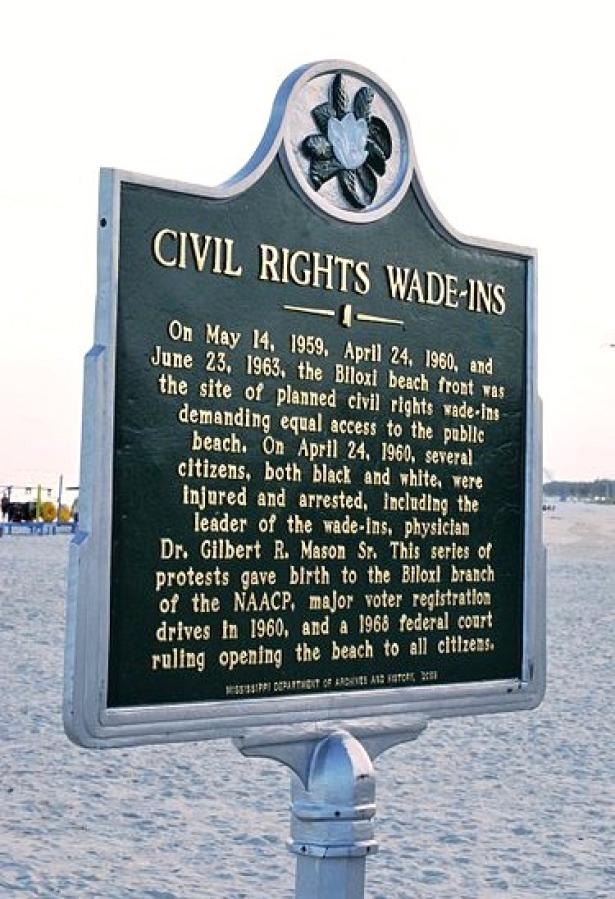Mississippi Racists Don’t Give In Easy
65 YEARS AGO, on May 14, 1959, the modern era’s first major civil rights campaign in Mississippi began when Black physician Gilbert Mason attempted to swim with a group of friends at a whites-only section of Biloxi Beach on the Gulf of Mexico. Mason and his friends left the beach when threatened with arrest for violating the state’s segregation laws. But they soon established the Biloxi chapter of the NAACP, with Mason as chapter president. It took more than nine years, many demonstrations, more than 100 arrests and a federal court order, but in 1968 the city’s beaches were finally desegregated. https://www.blackpast.org/african-american-history/events-african-american-history/biloxi-wade-ins-1959-1963/
Bessie Smith, Fortune-Teller?
95 YEARS AGO, on May 15, 1929, Bessie Smith recorded one of her biggest hits, the Jimmie Cox blues ballad “Nobody Knows You When You’re Down and Out,” for the Columbia label. By chance, the record was released on September 13, just weeks before the Wall Street meltdown that ushered in the Great Depression. As a result, the Bessie Smith-Jimmie Cox collaboration became an anthem of the era. You can listen to it here: https://youtu.be/Zea-1Fzi9JQ?si=-UKNvrNIN3R0uVbX
Fortress Germany Unveiled
85 YEARS AGO, on May 16, 1939, only 16 weeks before the beginning of World War 2, the Third Reich rattled its saber at deafening volume. Hitler and a large high-ranking entourage took a week-long, well-publicized inspection tour of West Wall, a 390-mile line of fortifications where Germany bordered on the Netherlands, Belgium, Luxembourg and France.
Hitler and his aides took every opportunity to emphasize and display the strength and depth of Germany’s western defenses, saying explicitly that any attempt to attack Germany from the west would be futile. The message was clear: Germany could attack Poland (on the east) without fearing attack from the west. France and its allies got the message. Less than four months later, when Germany invaded Poland, France and the United Kingdom, which were obliged by treaty to come to Poland’s defense, did almost nothing. Fighting on Germany’s western border did not begin until the spring of 1940, when Germany launched its lightning attack and overran all resistance in a matter of weeks.
“The Germans Are Coming!” Or Not.
105 YEARS AGO, on May 17, 1919, World War 1 had been over for six months. The U.S. Army had a confession to make.
Before the U.S. had entered the war, its people had been sharply divided over what, if anything, to do about the fighting in Europe, so the Wilson administration had used every possible trick to persuade Congress to declare war. On this day in May 1919, the public learned that one of those tricks involved bald-faced lies.
For more than a year before Congress eventually agreed to declare war, the Wilson administration’s military leadership had been claiming that the U.S. was in grave danger of being invaded by Germany. As far-fetched as the idea seemed, ever since the spring of 1915 the War Department had been insisting that Germany was capable of launching an overwhelming sea-borne invasion of the U.S. In September 1915, the Army published a 20-page study – entitled "Statement of a Proper Military Policy for the United States" – concluding that Germany would need only two months to land more than 825,000 fully-equipped soldiers on the Atlantic coast of the U.S. When the study was published, the U.S. Army, Navy, and National Guard had a combined force of only 375,000. After more than four years of insisting that the danger of a German invasion was (or had been) real, and after Germany had been defeated, the brass admitted that its study had been based on “gross exaggerations” and that the “alleged facts” behind the 1915 study “were quite impossible.” https://timesmachine.nytimes.com/timesmachine/1919/05/18/98285181.pdf
¡Karen Silkwood, Presente!
45 YEARS AGO, on May 18, 1979, a federal jury awarded the family of union organizer and occupational- safety-and-health martyr Karen Silkwood $10.5 million in civil damages for the negligence of her former employer, Kerr-McGee. The lawsuit was based on the charge that Kerr-McGee’s negligence had resulted in Silkwood becoming contaminated with plutonium while working at the Kerr-McGee nuclear fuel processing plant, before she died in a 1-car automobile crash. Kerr-McGee appealed the verdict to the U.S. Supreme Court, which ruled in favor of the family, but then when Kerr-McGee threatened to file a new appeal based on other grounds, the family agreed to settle the matter for $1.38 million. https://www.ncbi.nlm.nih.gov/pmc/articles/PMC1651625/
Big Brother Really Is Listening
105 YEARS AGO, on May 19, 1919, the U. S. government started its first peacetime program to secretly intercept civilian cable and telephone messages. The so-called Cable and Telegraph Section was jointly funded by the Army and the State Department, even though it was never authorized by Congress. Commercial U.S. communications companies gave what was known as the Black Chamber access to all messages they transmitted to or from the U.S. At the time the Black Chamber was established, there was not a law that clearly made wiretapping illegal, but the operation was kept secret because the government did not want its targets to know about the eavesdropping. Not much is known about the Black Chamber’s activities, because most of the records about it were destroyed before they were understood to have historical value. https://en.wikipedia.org/wiki/Black_Chamber
“Rock Around the Clock”
70 YEARS AGO, on May 20, 1954, “Rock Around the Clock,” written by Max C. Freedman and James E. Myers and performed by Bill Haley & His Comets was released by Decca. It quickly became the top-selling single and remained there for two months. https://youtu.be/9eZoqlAOSRs?si=zkQPuqH1F2pOILWC


Spread the word